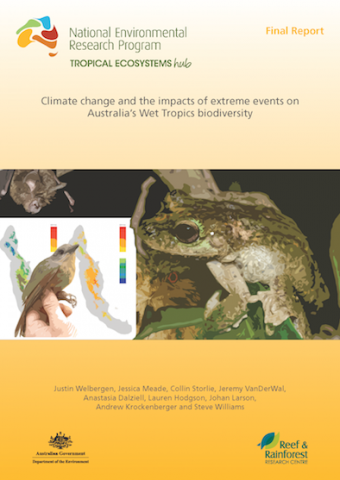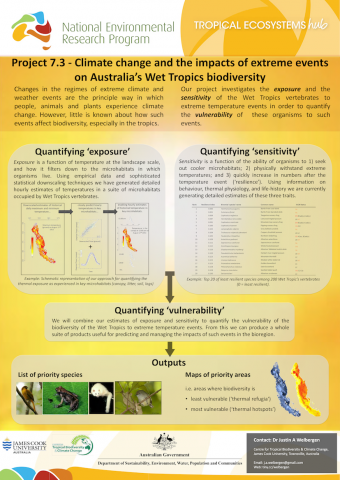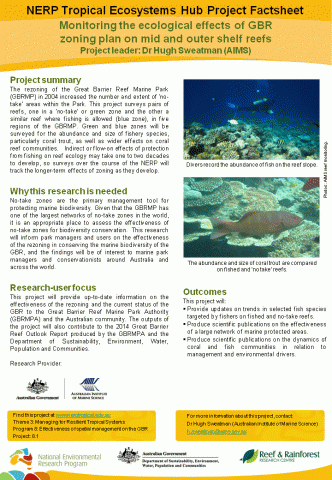Resources

Perspectives in Plant Ecology, Evolution and Systematics
Catford, J.A., Daehler, C.C., Murphy, H.T., Sheppard, A.W., Hardesty, B.D., Westcott, D.A., Rejmánek, M., Bellingham, P.J., Pergl, J, Horvitz, C.C., Hulme, P.E. (2012) The intermediate disturbance hypothesis and plant invasions: Implications for species richness and management. Perspectives in Plant Ecology, Evolution and Systematics. 14 (3), 231-241 doi: 10.1016/j.ppees.2011.12.002.

 The project will investigate the exposure and sensitivity of Wet Tropics plants and animals to extreme climatic events, such as heat waves, fires, flooding rain and cyclones.
The project will investigate the exposure and sensitivity of Wet Tropics plants and animals to extreme climatic events, such as heat waves, fires, flooding rain and cyclones.
 Welbergen J. A., Meade, J., Storlie, C., VanDerWal, J., Dalziell, A. H., Hodgson, L., Larson, J., Krockenberger, A., Williams, S. E. (2015) Climate change and the impacts of extreme events on Australia’s Wet Tropics biodiversity.
Welbergen J. A., Meade, J., Storlie, C., VanDerWal, J., Dalziell, A. H., Hodgson, L., Larson, J., Krockenberger, A., Williams, S. E. (2015) Climate change and the impacts of extreme events on Australia’s Wet Tropics biodiversity.
© JCU

Reside, A.E., Welbergen, J.A., Phillips, B.L., Wardell-Johnson, G.W., Keppel, G., Ferrier, S., Williams, S.E., VanDerWal, J. (2014) Characteristics of climate change refugia for Australian biodiversity. Austral Ecology. [doi: 10.1111/aec.12146].


Warren, R., VanDerWal, J., Price, J., Welbergen, A., Atkinson, I., Ramirez-Villegas, J., Osborn, T.J., Jarvis, A., Shoo, L.P., Williams, E., Lowe, E. (2013) Quantifying the benefit of early climate change mitigation in avoiding biodiversity loss. Nature Climate Change. 3, 678-682 [doi:10.1038/nclimate1887].

Storlie, C., Merino-Viteri, A., Phillips, B., VanDerWal, J., Welbergen, J., Williams, S.. (2014) Stepping inside the niche: microclimate data are critical for accurate assessment of species' vulnerability to climate change. Biology Letters. 10 (12) [doi: 10.1098/rsbl.2014.0576].

 Climate change and the impacts of extreme events on Australia’s Wet Tropics biodiversity.
Climate change and the impacts of extreme events on Australia’s Wet Tropics biodiversity.

 The rezoning of the Great Barrier Reef Marine Park (GBRMP) in 2004 increased the number and extent of ‘no-take’ areas within the Park. This project surveys pairs of reefs, one in a ‘no-take’ or green zone and the other a similar reef where fishing is allowed (blue zone), in five regions of the GBRMP. Green and blue zones will be surveyed for the abundance and size of fishery species, particularly coral trout, as well as wider effects on coral reef communities. Indirect or flow-on effects of protection from fishing on reef ecology may take one to two decades to develop, so surveys over the course of the NERP will track the longer-term effects of zoning as they develop.
The rezoning of the Great Barrier Reef Marine Park (GBRMP) in 2004 increased the number and extent of ‘no-take’ areas within the Park. This project surveys pairs of reefs, one in a ‘no-take’ or green zone and the other a similar reef where fishing is allowed (blue zone), in five regions of the GBRMP. Green and blue zones will be surveyed for the abundance and size of fishery species, particularly coral trout, as well as wider effects on coral reef communities. Indirect or flow-on effects of protection from fishing on reef ecology may take one to two decades to develop, so surveys over the course of the NERP will track the longer-term effects of zoning as they develop.


